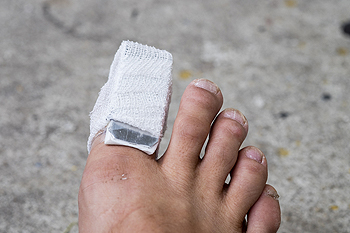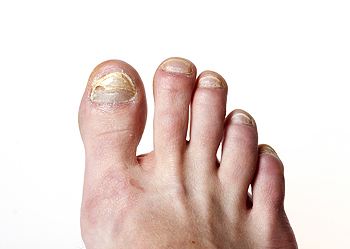Connect With Us
Blog
Items filtered by date: May 2022
Taking Care of Feet Before Foot Pain Develops

The feet are the foundation of the body, and many people do not pay attention to their feet properly until foot pain occurs. Research has indicated that approximately 70% of Americans experience foot pain sometime in their lives, which may lead to injuries unless the cause is identified and treated. A common reason that many people have foot pain is from wearing shoes that do not fit correctly. This can lead to bunions and hammertoe, which eventually may require surgery for permanent relief. Plantar fasciitis can result from standing on hard surfaces for the majority of the day. Stretching the calves and Achilles tendon frequently can help to relieve the pain. Many runners develop stress fractures from increasing speed and mileage too quickly. Ankle sprains are another common source of foot pain. This can happen from unexpectedly stepping off of a step or curb and twisting the ankle beyond its normal range of motion. If you have foot pain for any reason, it is strongly suggested that you are under the care of a podiatrist who can determine the cause and guide you toward correct treatment methods.
Foot Pain
Foot pain can be extremely painful and debilitating. If you have a foot pain, consult with one of our podiatrists from Cleveland Foot & Ankle Clinic. Our doctors will assess your condition and provide you with quality foot and ankle treatment.
Causes
Foot pain is a very broad condition that could be caused by one or more ailments. The most common include:
- Bunions
- Hammertoes
- Plantar Fasciitis
- Bone Spurs
- Corns
- Tarsal Tunnel Syndrome
- Ingrown Toenails
- Arthritis (such as Gout, Rheumatoid, and Osteoarthritis)
- Flat Feet
- Injury (from stress fractures, broken toe, foot, ankle, Achilles tendon ruptures, and sprains)
- And more
Diagnosis
To figure out the cause of foot pain, podiatrists utilize several different methods. This can range from simple visual inspections and sensation tests to X-rays and MRI scans. Prior medical history, family medical history, and any recent physical traumatic events will all be taken into consideration for a proper diagnosis.
Treatment
Treatment depends upon the cause of the foot pain. Whether it is resting, staying off the foot, or having surgery; podiatrists have a number of treatment options available for foot pain.
If you have any questions, please feel free to contact our offices located in Cleveland, Independence, and Kent, OH . We offer the newest diagnostic and treatment technologies for all your foot care needs.
See Your Foot Specialist Regularly If You Work On Your Feet
Have I Broken or Sprained My Toe?

Many people have stubbed their toe by hitting it or dropping something heavy on it, felt pain, and wondered if it was broken. It might be a sprain but it is important to know if the toe is broken because if left untreated, a broken toe can lead to problems in movement and later down the road, potential for osteoarthritis or nerve damage. If you hear a bone break, feel intense pain and the toe swells, see discoloration, or have trouble putting weight on it, the toe might be broken. With a bad break, there can be a dislocation and the toe will look like it is at an odd angle. With a sprained toe, all the same symptoms may be present but the toe should not look dislocated and it should feel better sooner than a broken toe. Also, with a break, the pain is often felt right where the fracture has taken place versus being more generalized around the toe with a sprain. Prevent such injuries to your toes by refraining from going barefoot, especially in the dark and in unfamiliar areas. If symptoms do not get better in a few days, it is suggested to see a podiatrist who will take X-rays and provide you with a definitive diagnosis and appropriate treatment.
Broken toes may cause a lot of pain and should be treated as soon as possible. If you have any concerns about your feet, contact one of our podiatrists from Cleveland Foot & Ankle Clinic. Our doctors will treat your foot and ankle needs.
What Is a Broken Toe?
A broken toe occurs when one or more of the toe bones of the foot are broken after an injury. Injuries such as stubbing your toe or dropping a heavy object on it may cause a toe fracture.
Symptoms of a Broken Toe
- Swelling
- Pain (with/without wearing shoes)
- Stiffness
- Nail Injury
Although the injured toe should be monitored daily, it is especially important to have a podiatrist look at your toe if you have severe symptoms. Some of these symptoms include worsening or new pain that is not relieved with medication, sores, redness, or open wounds near the toe.
If you have any questions please feel free to contact our offices located in Cleveland, Independence, and Kent, OH . We offer the newest diagnostic tools and technology to treat your foot and ankle needs.
Do I Have Toenail Fungus?

Toenail fungus, or onychomycosis, is an infection of the toenail that causes the nail to become discolored, thick, and prone to cracking and breaking. There is typically no pain associated with toenail fungus unless it becomes severe. Fungal nail infections are caused by different types of yeasts or molds in the environment that can get into the nail and cause an infection. The elderly, diabetics, those with weakened immune systems or blood circulatory problems, and those with athlete’s foot are more apt to get toenail fungus. To prevent toenail fungus, regularly wash and dry the feet, clip toenails straight across, do not walk barefoot in public areas, and beware of those who might have athlete’s foot as it is highly contagious. Visit a podiatrist to have your toenails checked if you suspect you have toenail fungus for a diagnosis and suggestions for treatment.
If left untreated, toenail fungus may spread to other toenails, skin, or even fingernails. If you suspect you have toenail fungus it is important to seek treatment right away. For more information about treatment, contact one of our podiatrists of Cleveland Foot & Ankle Clinic. Our doctors can provide the care you need to keep you pain-free and on your feet.
Symptoms
- Warped or oddly shaped nails
- Yellowish nails
- Loose/separated nail
- Buildup of bits and pieces of nail fragments under the nail
- Brittle, broken, thickened nail
Treatment
If self-care strategies and over-the-counter medications does not help your fungus, your podiatrist may give you a prescription drug instead. Even if you find relief from your toenail fungus symptoms, you may experience a repeat infection in the future.
Prevention
In order to prevent getting toenail fungus in the future, you should always make sure to wash your feet with soap and water. After washing, it is important to dry your feet thoroughly especially in between the toes. When trimming your toenails, be sure to trim straight across instead of in a rounded shape. It is crucial not to cover up discolored nails with nail polish because that will prevent your nail from being able to “breathe”.
In some cases, surgical procedure may be needed to remove the toenail fungus. Consult with your podiatrist about the best treatment options for your case of toenail fungus.
If you have any questions, please feel free to contact our offices located in Cleveland, Independence, and Kent, OH . We offer the newest diagnostic and treatment technologies for all your foot care needs.
Is Podiatry for Me?

A doctor who specializes in foot care is known as a podiatrist. There are several reasons why patients visit podiatrists, including having conditions such as hammertoes, bunions, and plantar fasciitis. Research has shown that the feet often show early signs of other conditions that may be present in the body, which may include diabetes and heart disease. People who choose to pursue this field of medicine as a career will need to obtain a bachelor’s degree, followed by attending a podiatry school for four years. A residency is then completed, which precedes obtaining a license. Podiatrists can work in a private or group practice or specialize in specific areas which can include sports medicine and diabetic foot care. If you are considering a career in podiatry, it is beneficial to speak with a podiatrist who can help you to determine if this is the right choice for you.
If you are experiencing pain in the feet or ankles, don’t join the stubborn majority refusing treatment. Feel free to contact one of our podiatrists from Cleveland Foot & Ankle Clinic. Our doctors can provide the care you need to keep you pain-free and on your feet.
What Is a Podiatrist?
Someone would seek the care of a podiatrist if they have suffered a foot injury or have common foot ailments such as heal spurs, bunions, arch problems, deformities, ingrown toenails, corns, foot and ankle problems, etc.
Podiatric Treatment
A podiatrist will treat the problematic areas of the feet, ankle or lower leg by prescribing the following:
- Physical therapy
- Drugs
- Orthotic inserts or soles
- Surgery on lower extremity fractures
A common podiatric procedure a podiatrist will use is a scanner or force plate which will allow the podiatrist to know the designs of orthotics. Patients are then told to follow a series of tasks to complete the treatment. The computer will scan the foot a see which areas show weight distribution and pressure points. The podiatrist will read the analysis and then determine which treatment plans are available.
If you have any questions please feel free to contact our offices located in Cleveland, Independence, and Kent, OH . We offer the newest diagnostic and treatment technologies for all your foot and ankle needs.
Blog Archives
- November 2025
- October 2025
- September 2025
- August 2025
- July 2025
- June 2025
- May 2025
- April 2025
- March 2025
- February 2025
- January 2025
- December 2024
- November 2024
- October 2024
- September 2024
- August 2024
- July 2024
- June 2024
- May 2024
- April 2024
- March 2024
- February 2024
- January 2024
- December 2023
- November 2023
- October 2023
- September 2023
- August 2023
- July 2023
- June 2023
- May 2023
- April 2023
- March 2023
- February 2023
- January 2023
- December 2022
- November 2022
- October 2022
- September 2022
- August 2022
- July 2022
- June 2022
- May 2022
- April 2022
- March 2022

